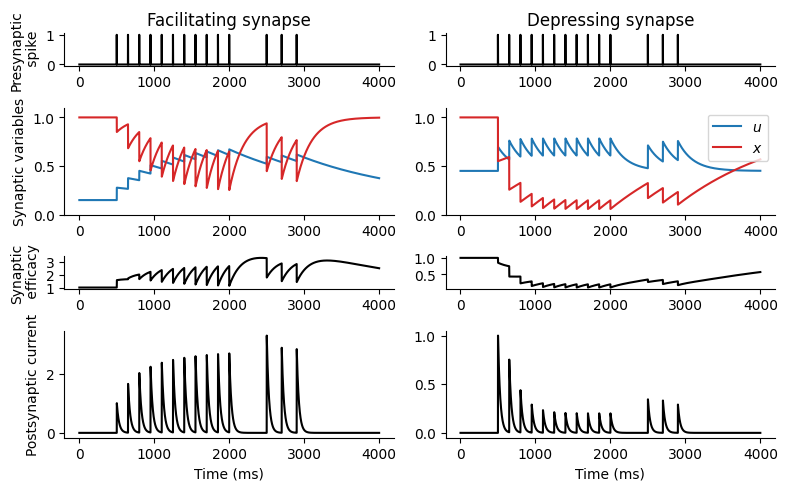動的シナプス
Contents
動的シナプス#
シナプス前活動に応じてシナプス伝達効率 (synaptic efficacy)が動的に変化する性質を短期的シナプス可塑性 (Short-term synaptic plasticity)といい,このような性質を持つシナプスを動的シナプス (dynamical synapses)と呼ぶ.シナプス伝達効率が減衰する現象を短期抑圧 (short-term depression; STD),増強する現象を短期促通(short-term facilitation; STF)という.さらにそれぞれに対応するシナプスを減衰シナプス,増強シナプスという.
ここでは[Mongillo et al., 2008]および[Orhan and Ma, 2019]で用いられている定式化を使用する.
ただし,定数は以下のようにする.
STSP neurotransmitter time constant: \(\tau_x\) 200 ms/1,500 ms (facilitating/depressing)
STSP neurotransmitter utilization: \(\tau_u\) 1,500 ms/200 ms (facilitating/depressing)
STSP neurotransmitter increment: \(U\) 0.15/0.45 (facilitating/depressing)
Time step (training and testing): \(\Delta t\) 10ms
\(x\): the fraction of available neurotransmitter
\(u\): the neurotransmitter utilization
using PyPlot
rc("axes.spines", top=false, right=false)
# ms
Uf, τfₓ, τfᵤ = 0.15, 200, 1500
Ud, τdₓ, τdᵤ = 0.45, 1500, 200
dt = 1
T = 4000
tarray = 1:dt:T;
nt = Int(T/dt);
s = zeros(nt) # stimuli
s[500:150:2000] .= 1;
s[2500:200:3000] .= 1;
# short-term synaptic plasticity
function stsp(dt, T, s, U, τₓ, τᵤ, τₛ=30)
nt = Int(T/dt);
αₓ, αᵤ, αₛ = dt/τₓ, dt/τᵤ, dt/τₛ # 時定数を減衰率に変換
u, x, r = zeros(nt), zeros(nt), zeros(nt)
u[1], x[1] = U, 1
for t in 1:nt-1
x[t+1] = x[t] + αₓ*(1-x[t]) - u[t]*x[t]*s[t]
u[t+1] = u[t] + αᵤ*(U-u[t]) + U*(1-u[t])*s[t]
x[t+1], u[t+1] = clamp.([x[t+1], u[t+1]], 0, 1) # for numerical stability
r[t+1] = (1-αₛ)*r[t] + u[t]*x[t]*s[t]/U
end
return u, x, r
end;
# simulation
uf, xf, rf = stsp(dt, T, s, Uf, τfₓ, τfᵤ)
ud, xd, rd = stsp(dt, T, s, Ud, τdₓ, τdᵤ);
# compute synaptic efficacy
xuf = uf .* xf / Uf
xud = ud .* xd / Ud;
figure(figsize=(8, 5))
subplot2grid((6, 2), (0, 0)); title("Facilitating synapse"); plot(tarray, s, "k"); ylabel("Presynaptic\n spike");
subplot2grid((6, 2), (0, 1)); title("Depressing synapse"); plot(tarray, s, "k");
subplot2grid((6, 2), (1, 0), rowspan=2); plot(tarray, uf); plot(tarray, xf, "tab:red"); ylabel("Synaptic variables"); ylim(0, 1.1);
subplot2grid((6, 2), (1, 1), rowspan=2); plot(tarray, ud, label=L"$u$"); plot(tarray, xd, "tab:red", label=L"$x$"); ylim(0, 1.1); legend()
subplot2grid((6, 2), (3, 0)); plot(tarray, xuf, "k"); ylabel("Synaptic\n efficacy")
subplot2grid((6, 2), (3, 1)); plot(tarray, xud, "k");
subplot2grid((6, 2), (4, 0), rowspan=2); plot(tarray, rf, "k"); xlabel("Time (ms)"); ylabel("Postsynaptic current")
subplot2grid((6, 2), (4, 1), rowspan=2); plot(tarray, rd, "k"); xlabel("Time (ms)")
tight_layout()

参考文献#
- MBT08
Gianluigi Mongillo, Omri Barak, and Misha Tsodyks. Synaptic theory of working memory. Science, 319(5869):1543–1546, 2008.
- OM19
A Emin Orhan and Wei Ji Ma. A diverse range of factors affect the nature of neural representations underlying short-term memory. Nat. Neurosci., 22(2):275–283, January 2019.

